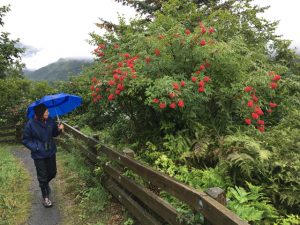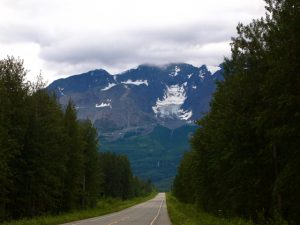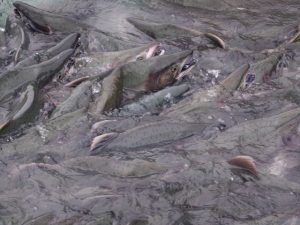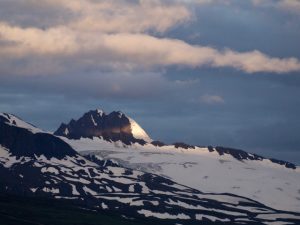
gallery of images from this leg of our trip.
The seasonal national park ranger was really tall, maybe 6’ 4” and sturdily built. As always, we thrived on information provided by these dedicated servants working in our nations national treasures. What really impressed me, however, was when he raised his arms and said something to the effect, “This is how much it rains up here.” Considering how much it has dumped on us, I’d say we’ve experienced enough to reach his ankle’s. Fortunately, the 900 or so miles we’ve covered since beginning the driving section of our road trip in Haines was suited to inclement weather. Reasonable driving distances, overnight camping, stopping for wildlife, and pushing on.
Valdez was a pleasant surprise. The BIG surprise was supposed to be Wrangell St. Elias National Park but, due to the rain, that was a bust. Sad, but true. It poured, many times all day, and sometimes into the night. Our camper’s new one-piece aluminum roof served us well and our daytime activities were not compromised. Recreation opportunities abound in Alaska, and outfitted in binoculars, camera, boots and bear spray we made the most of it. Hiking national park trails were not that compelling in the rain, but birds don’t seem to mind and our photo galleries are peppered with an odd assortment of wildlife. (Clicking any of the photos illustrating this post will take you to our most recent gallery of images. Clicking a thumbnail will present the photos in a slideshow format you may enjoy.)
So what is it about Valdez that intrigued us? There was no overt negative reference to the catastrophic oil spill from ’89. (In fact, $37.5 million of the Exxon Valdez oil spill settlement was dedicated to the research and rehabilitation arm of Seward’s Alaska SeaLife Center that we thoroughly enjoyed.) It was the drive TO Valdez that knocked us out—massive snow-covered peaks sandwiching forested highway more than fulfilled my stereotypical image of driving through Alaska. The drive up to that point was lovely with low clouds shrouding the peaks with a grey blanket. Thousands of acres of stunted black spruce, often referred to as “drunken trees” were our constant companion, interspersed with the occasional pond that really got Sooney’s attention. The spruce got this moniker because the permanently frozen ground called permafrost, is melting at an unprecedented rate due to global chaos. The ground buckles and sinks, causing trees to list at extreme angles. The ponds often teemed with wildlife: Trumpeter swans preening their cygnets, water birds diving for that tasty morsel, eagles overseeing the entire show from an elevated perch, and not a single bear or moose.

gallery of images from this leg of our trip.
As we approached Valdez, however, everything changed. Blue sky appeared and our spirits lifted. The effect was breathtaking—on several occasions I pulled over and snapped away. I had to. You would have, too. And then we saw the Worthington Glacier. Even better, we camped at Blueberry Lake state park near Thompson pass and located in the shadow of the glacier. From our campground, by far the best in the park, we had access to a ridge where we set up our chairs and watched the sunlight dance from peak to peak across the valley. Every minute another drainage, glacial moraine, jagged uplift or snowy bowl was featured, each an embellishment of the former. It was like a fireworks show where you were afraid to leave for fear of missing something grander that what you just saw. The iPhone’s panorama feature repeatedly became my tool of choice—it’s fun scrolling across those wiiiiide photos and I’m always amazed at the quality and variety of what they capture. Alas, the following morning we awakened to socked-in fog, damp, uninviting, and completely obscuring the magic from the previous evening. The good news was the abundance of blueberries we picked for our pancakes. Memories of Valdez will always conjure up that sunset—that and the Pinks, of course.

Click for more images in our latest gallery.
We’d read about the five varieties of Alaskan salmon that return to breed in streams from May to September. It was nevertheless a shock when we saw thousands of Pink Salmon dutifully returning to their birthplace, the Solomon Gulch Fish Hatchery. Sadly, their desire to spawn is thwarted by the hatchery’s alternative strategy of breeding and releasing zillions of salmon fry solely for wildlife propagation. After a 4-5 years at sea, these poor saps piled upon each other attempting to pass through the hatchery’s counting weir. Those unsuccessful were easy prey to otters, sea lions, black bears, kittiwakes, glaucous-winged gulls, and other seabirds all vying for the catch of the day. Nearby, anglers were casting out just about anything with baffling success. Although pink salmon are processed and canned for marketing, I suspect most of those fishing were pulling ‘em in both for sport and maybe some chowder. Much will most likely end up[ as food for domesticated animals as well as their wild cousins. Clearly there was enough for everybody so we wet a line as well, choosing a nondescript stream in an industrial park with a derelict John Deere tractor as our only companion. It’s that kind to town.
The next morning we got word that a bird new to us was lurking near Mike’s RV repair shop where Marty was having his camper serviced. We beelined it there and stalked the elusive little critter, the Common Redpoll, in some nearby woods. After a half hour, we happened onto some bird feeders under an overhang and soon counted 5 other birds in nearby cottonwoods. What we’ve grown accustomed to here in Alaska is the myriad of wildlife co-habituating with broken vehicles of every imaginable variety. I suppose it’s simply too expensive to dispose of them, and with 18-20 hours of sunlight in the summer, native plants rapidly grow over the eyesores. Winter’s even less a challenge as snowfall completes the deception.

Click for more images in this gallery.
While Valdez entertained us with its unpretentiousness, we had a date with Glacier Fjord National Park across the Prince William Sound. The 6am ferry was our final voyage with Alaska Marine and I was dulled back to sleep as the foggy panorama failed to compete with the dynamic map displayed on the video screen in the lounge. An hour later things changed as happens with uncanny frequency in Alaska. Out of the mist we saw an unbelievable sight: sunrise! Glaciers and snow-clad ranges surrounded us as we narrowed our way through the sound, fjord after fjord leading to glorious destinations of white. High in the distance, peaks were golden, framed with a background of high, wispy clouds and cobalt blue skies. It continued like that for the reminder of the 5-hour ride to Whittier, a deep-water port that features very little more. From there, we drove through an unusual 2.5 mile, one-way tunnel to, of all places, the other side. It’s the longest tunnel in North America, and is shared with a railroad freight line. Steering on a road with tracks is a white-knuckle affair, with gnarly granite walls a mere 3’ from either mirror of our truck, or so it appeared. Our destination was Seward, and much of the hour drive was shared with RV after RV as residents from Anchorage fled the “big” city to Alaska’s playground: the Kenai Peninsula.
We were traveling caravan style with our dear friends, fellow musicians and birders Marty and Terry. After a supply stop at the surprisingly adequate Seward Safeway, we cozied next to them in the city-owned RV campground right on the bay at the south end of town. Only a bike path and some fire rings separated us from the sea otters as they waved at us from the comfort of their living room. Imagine, a mile of waterfront dedicated to tourists and their appreciated camping fees. Even better, the spot next to us dry campers was day use only, creating some space between us and the hooked-up juicers parked in another section of the RV park. Having sat much of the day, we strolled into town, checked out the Alaska SeaLand Center and got sucked into the Yukon Bar for an beer and some open-mike entertainment. A Seward landmark, the Yukon has thousands of dollar bills pinned to the ceiling, filling every nook and cranny and barely illuminated in the ambient light streaming through the front door and by a couple Pabst Blue Ribbon neons. Combined with good tunes and friendly people, I stopped trying to imagine how they’ve been dusting those now-crispy bills since the bar opened over 50 years ago. Being oldsters, we left before things heated up and briefly visited with some guys busily setting up a food stall across the street on a flatbed trailer. They would be open from 11pm to closing, serving Hawaiian tacos to the bar crowd. Later that night, some guy backed his popup trailer into the day use spot next to our camper and wore off his buzz with annoying chatter for an hour or so—quite a contrast to the other 6-7 state campgrounds we’d enjoyed on the Haines Highway getting this far. An interesting interpretation of “day use,” the guy was outta there before breakfast.
Bird & critter sightings:
Haines-Haines Junction
Red Squirrel, Trumpeter Swan, Red-tailed Hawk, Barn Swallow
Haines Junction-Dezadeash Campground
Lynx, Slate-colored Junco, Black-billed Magpie, Common Loon
Snag Junction
*Red-necked Grebe (with striped-headed juveniles), American Kestrel
Swan Lake (north of Beaver Creek)
Trumpeter Swan with 3 cygnets, Bald Eagle, American Wigeon, Spotted Sandpiper, Ring-necked duck, Canvasback duck and ducklings
Tetlin Wildlife Refuge
Cliff Swallows, Lesser Yellowlegs, Barrows Goldeneye, Pacific Loon, Horned Grebe, Gray Jay
Richardson Hwy. (en-route to Valdez from Tok)
Green-winged Teal, Common Goldeneye
Nabesna Road – Kendesnii campground
Trumpeter Swans swimming w 3 cygnets, White-crowned Sparrow, Yellow-rumped Warbler, Common Goldeneye, Mallard, Black Scoters
Gakona Alaska RV Park
Magpies, White-winged Crossbills, Slate-colored Junco
Gulkana River (on the Richardson Hwy.)
Mew Gull
Wrangell/St. Elias National Park visitor center (near Copper Center)
*Bohemian Waxwing
Liberty Falls Campground
Gray Jay, Slate-colored Junco, Yellow-rumped Warbler
Blueberry Lake State Campground
Golden-crowned Sparrow
Valdez
*Common Redpoll, American Dipper, White-crowned Sparrow, Golden-crowned Sparrow
Alaska Marine Ferry (Valdez-Whittier)
*Arctic Tern
4 life birds ( 9 total for this journey)
